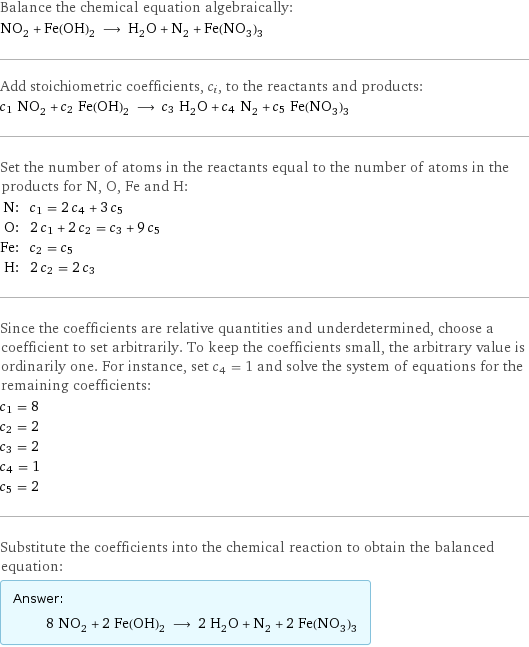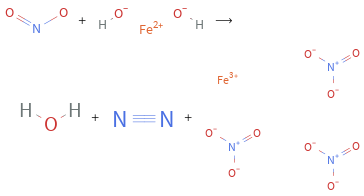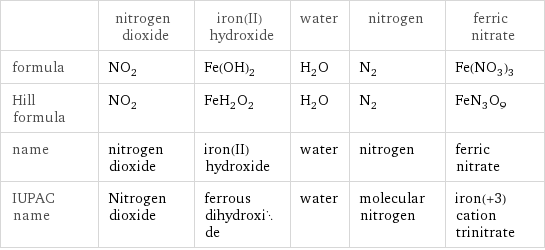Input interpretation

NO_2 nitrogen dioxide + Fe(OH)_2 iron(II) hydroxide ⟶ H_2O water + N_2 nitrogen + Fe(NO_3)_3 ferric nitrate
Balanced equation

Balance the chemical equation algebraically: NO_2 + Fe(OH)_2 ⟶ H_2O + N_2 + Fe(NO_3)_3 Add stoichiometric coefficients, c_i, to the reactants and products: c_1 NO_2 + c_2 Fe(OH)_2 ⟶ c_3 H_2O + c_4 N_2 + c_5 Fe(NO_3)_3 Set the number of atoms in the reactants equal to the number of atoms in the products for N, O, Fe and H: N: | c_1 = 2 c_4 + 3 c_5 O: | 2 c_1 + 2 c_2 = c_3 + 9 c_5 Fe: | c_2 = c_5 H: | 2 c_2 = 2 c_3 Since the coefficients are relative quantities and underdetermined, choose a coefficient to set arbitrarily. To keep the coefficients small, the arbitrary value is ordinarily one. For instance, set c_4 = 1 and solve the system of equations for the remaining coefficients: c_1 = 8 c_2 = 2 c_3 = 2 c_4 = 1 c_5 = 2 Substitute the coefficients into the chemical reaction to obtain the balanced equation: Answer: | | 8 NO_2 + 2 Fe(OH)_2 ⟶ 2 H_2O + N_2 + 2 Fe(NO_3)_3
Structures

+ ⟶ + +
Names

nitrogen dioxide + iron(II) hydroxide ⟶ water + nitrogen + ferric nitrate
Equilibrium constant
![Construct the equilibrium constant, K, expression for: NO_2 + Fe(OH)_2 ⟶ H_2O + N_2 + Fe(NO_3)_3 Plan: • Balance the chemical equation. • Determine the stoichiometric numbers. • Assemble the activity expression for each chemical species. • Use the activity expressions to build the equilibrium constant expression. Write the balanced chemical equation: 8 NO_2 + 2 Fe(OH)_2 ⟶ 2 H_2O + N_2 + 2 Fe(NO_3)_3 Assign stoichiometric numbers, ν_i, using the stoichiometric coefficients, c_i, from the balanced chemical equation in the following manner: ν_i = -c_i for reactants and ν_i = c_i for products: chemical species | c_i | ν_i NO_2 | 8 | -8 Fe(OH)_2 | 2 | -2 H_2O | 2 | 2 N_2 | 1 | 1 Fe(NO_3)_3 | 2 | 2 Assemble the activity expressions accounting for the state of matter and ν_i: chemical species | c_i | ν_i | activity expression NO_2 | 8 | -8 | ([NO2])^(-8) Fe(OH)_2 | 2 | -2 | ([Fe(OH)2])^(-2) H_2O | 2 | 2 | ([H2O])^2 N_2 | 1 | 1 | [N2] Fe(NO_3)_3 | 2 | 2 | ([Fe(NO3)3])^2 The equilibrium constant symbol in the concentration basis is: K_c Mulitply the activity expressions to arrive at the K_c expression: Answer: | | K_c = ([NO2])^(-8) ([Fe(OH)2])^(-2) ([H2O])^2 [N2] ([Fe(NO3)3])^2 = (([H2O])^2 [N2] ([Fe(NO3)3])^2)/(([NO2])^8 ([Fe(OH)2])^2)](../image_source/6d5769d07c4a09e18fbe339c5eb0bab1.png)
Construct the equilibrium constant, K, expression for: NO_2 + Fe(OH)_2 ⟶ H_2O + N_2 + Fe(NO_3)_3 Plan: • Balance the chemical equation. • Determine the stoichiometric numbers. • Assemble the activity expression for each chemical species. • Use the activity expressions to build the equilibrium constant expression. Write the balanced chemical equation: 8 NO_2 + 2 Fe(OH)_2 ⟶ 2 H_2O + N_2 + 2 Fe(NO_3)_3 Assign stoichiometric numbers, ν_i, using the stoichiometric coefficients, c_i, from the balanced chemical equation in the following manner: ν_i = -c_i for reactants and ν_i = c_i for products: chemical species | c_i | ν_i NO_2 | 8 | -8 Fe(OH)_2 | 2 | -2 H_2O | 2 | 2 N_2 | 1 | 1 Fe(NO_3)_3 | 2 | 2 Assemble the activity expressions accounting for the state of matter and ν_i: chemical species | c_i | ν_i | activity expression NO_2 | 8 | -8 | ([NO2])^(-8) Fe(OH)_2 | 2 | -2 | ([Fe(OH)2])^(-2) H_2O | 2 | 2 | ([H2O])^2 N_2 | 1 | 1 | [N2] Fe(NO_3)_3 | 2 | 2 | ([Fe(NO3)3])^2 The equilibrium constant symbol in the concentration basis is: K_c Mulitply the activity expressions to arrive at the K_c expression: Answer: | | K_c = ([NO2])^(-8) ([Fe(OH)2])^(-2) ([H2O])^2 [N2] ([Fe(NO3)3])^2 = (([H2O])^2 [N2] ([Fe(NO3)3])^2)/(([NO2])^8 ([Fe(OH)2])^2)
Rate of reaction
![Construct the rate of reaction expression for: NO_2 + Fe(OH)_2 ⟶ H_2O + N_2 + Fe(NO_3)_3 Plan: • Balance the chemical equation. • Determine the stoichiometric numbers. • Assemble the rate term for each chemical species. • Write the rate of reaction expression. Write the balanced chemical equation: 8 NO_2 + 2 Fe(OH)_2 ⟶ 2 H_2O + N_2 + 2 Fe(NO_3)_3 Assign stoichiometric numbers, ν_i, using the stoichiometric coefficients, c_i, from the balanced chemical equation in the following manner: ν_i = -c_i for reactants and ν_i = c_i for products: chemical species | c_i | ν_i NO_2 | 8 | -8 Fe(OH)_2 | 2 | -2 H_2O | 2 | 2 N_2 | 1 | 1 Fe(NO_3)_3 | 2 | 2 The rate term for each chemical species, B_i, is 1/ν_i(Δ[B_i])/(Δt) where [B_i] is the amount concentration and t is time: chemical species | c_i | ν_i | rate term NO_2 | 8 | -8 | -1/8 (Δ[NO2])/(Δt) Fe(OH)_2 | 2 | -2 | -1/2 (Δ[Fe(OH)2])/(Δt) H_2O | 2 | 2 | 1/2 (Δ[H2O])/(Δt) N_2 | 1 | 1 | (Δ[N2])/(Δt) Fe(NO_3)_3 | 2 | 2 | 1/2 (Δ[Fe(NO3)3])/(Δt) (for infinitesimal rate of change, replace Δ with d) Set the rate terms equal to each other to arrive at the rate expression: Answer: | | rate = -1/8 (Δ[NO2])/(Δt) = -1/2 (Δ[Fe(OH)2])/(Δt) = 1/2 (Δ[H2O])/(Δt) = (Δ[N2])/(Δt) = 1/2 (Δ[Fe(NO3)3])/(Δt) (assuming constant volume and no accumulation of intermediates or side products)](../image_source/0023a94f5c277dc54be1713a3bcfdaf4.png)
Construct the rate of reaction expression for: NO_2 + Fe(OH)_2 ⟶ H_2O + N_2 + Fe(NO_3)_3 Plan: • Balance the chemical equation. • Determine the stoichiometric numbers. • Assemble the rate term for each chemical species. • Write the rate of reaction expression. Write the balanced chemical equation: 8 NO_2 + 2 Fe(OH)_2 ⟶ 2 H_2O + N_2 + 2 Fe(NO_3)_3 Assign stoichiometric numbers, ν_i, using the stoichiometric coefficients, c_i, from the balanced chemical equation in the following manner: ν_i = -c_i for reactants and ν_i = c_i for products: chemical species | c_i | ν_i NO_2 | 8 | -8 Fe(OH)_2 | 2 | -2 H_2O | 2 | 2 N_2 | 1 | 1 Fe(NO_3)_3 | 2 | 2 The rate term for each chemical species, B_i, is 1/ν_i(Δ[B_i])/(Δt) where [B_i] is the amount concentration and t is time: chemical species | c_i | ν_i | rate term NO_2 | 8 | -8 | -1/8 (Δ[NO2])/(Δt) Fe(OH)_2 | 2 | -2 | -1/2 (Δ[Fe(OH)2])/(Δt) H_2O | 2 | 2 | 1/2 (Δ[H2O])/(Δt) N_2 | 1 | 1 | (Δ[N2])/(Δt) Fe(NO_3)_3 | 2 | 2 | 1/2 (Δ[Fe(NO3)3])/(Δt) (for infinitesimal rate of change, replace Δ with d) Set the rate terms equal to each other to arrive at the rate expression: Answer: | | rate = -1/8 (Δ[NO2])/(Δt) = -1/2 (Δ[Fe(OH)2])/(Δt) = 1/2 (Δ[H2O])/(Δt) = (Δ[N2])/(Δt) = 1/2 (Δ[Fe(NO3)3])/(Δt) (assuming constant volume and no accumulation of intermediates or side products)
Chemical names and formulas

| nitrogen dioxide | iron(II) hydroxide | water | nitrogen | ferric nitrate formula | NO_2 | Fe(OH)_2 | H_2O | N_2 | Fe(NO_3)_3 Hill formula | NO_2 | FeH_2O_2 | H_2O | N_2 | FeN_3O_9 name | nitrogen dioxide | iron(II) hydroxide | water | nitrogen | ferric nitrate IUPAC name | Nitrogen dioxide | ferrous dihydroxide | water | molecular nitrogen | iron(+3) cation trinitrate
Substance properties

| nitrogen dioxide | iron(II) hydroxide | water | nitrogen | ferric nitrate molar mass | 46.005 g/mol | 89.86 g/mol | 18.015 g/mol | 28.014 g/mol | 241.86 g/mol phase | gas (at STP) | | liquid (at STP) | gas (at STP) | solid (at STP) melting point | -11 °C | | 0 °C | -210 °C | 35 °C boiling point | 21 °C | | 99.9839 °C | -195.79 °C | density | 0.00188 g/cm^3 (at 25 °C) | | 1 g/cm^3 | 0.001251 g/cm^3 (at 0 °C) | 1.7 g/cm^3 solubility in water | reacts | | | insoluble | very soluble surface tension | | | 0.0728 N/m | 0.0066 N/m | dynamic viscosity | 4.02×10^-4 Pa s (at 25 °C) | | 8.9×10^-4 Pa s (at 25 °C) | 1.78×10^-5 Pa s (at 25 °C) | odor | | | odorless | odorless |
Units
